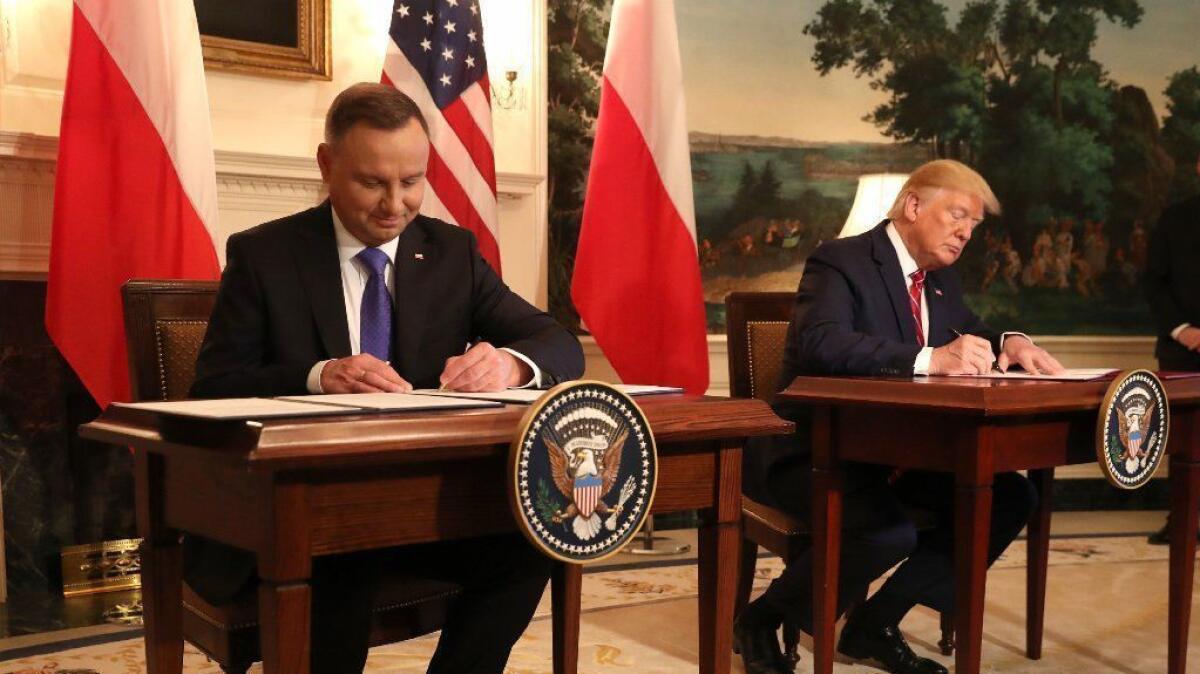U.S. will send more troops to Poland in a move likely to anger Russia

- Share via
Reporting from Washington — President Trump said Wednesday that he is shifting 1,000 U.S. troops from bases in Western Europe to Poland, but he stopped short of approving Warsaw’s request for a permanent U.S. military installation near Russia’s border.
Trump described the added troops, who will join about 4,000 U.S. soldiers who rotate in and out of Poland, as a “limited force,” and said Warsaw would pay to house them and build military facilities for American use.
Though modest in scope, the troop deployment, combined with a missile defense site that the Pentagon is building in Poland, is likely to spur new complaints from Moscow that the United States and NATO are taking a more aggressive posture in Central Europe near its borders.
Poland joined the North Atlantic Treaty Organization in 1999 after decades under Moscow’s control during the Cold War.
“The alliance between the United States and Poland is reaching extraordinary new heights in 2019,” Trump said with Polish President Andrzej Duda at the White House in an appearance that included a thundering flyover of two U.S.-made F-35 fighters.
Poland has promised to buy as many as 35 of the advanced warplanes.
U.S. forces being considered for Poland could include a squadron of U.S. Reaper drones and troops who specialize in logistics, one Pentagon official said.
U.S. and Polish officials also are discussing construction of training facilities, barracks for U.S. forces to use during rotations, an airfield and large-scale training ranges.
Trump sidestepped questions about whether the U.S. presence in Poland would be permanent, a sensitive issue with Moscow and within NATO, saying he didn’t want to “talk about permanence or nonpermanence.”
Although it is backed by the Pentagon, the deployment of U.S. forces on Russia’s periphery is in some ways anathema to Trump, who repeated Wednesday that he would like to see improvements in relations with Moscow.
When NATO expanded to take in countries that had been Soviet satellites during the Cold War, the alliance promised not to permanently station combat forces in Central Europe unless security condition change, a pledge that Moscow says NATO has violated. Many NATO members see the promise as important to preserve, at least on paper.
Since Russia annexed Crimea in 2014 and backed separatist groups in Ukraine, the Pentagon and NATO have built up forces in Central Europe, hoping to reassure nervous NATO members that the alliance would come to their defense, as promised in the NATO charter, if directly threatened by Russia. Ukraine is not a member of the alliance.
Current plans still call for rushing reinforcements and equipment from Germany, Italy and the United States to Central Europe if war breaks out — which the modest troop presence in Poland will not change
But for Poland, which has been invaded and carved up repeatedly by Russia and Germany over the centuries, a U.S. presence is seen as a long-term guarantee of security.
Ben Hodges, a retired U.S. Army lieutenant general who commanded U.S. troops in Europe until last year, said in an interview that Trump’s decision to commit more forces to Poland was helpful for building up U.S. credibility and for deterring Moscow.
Pentagon officials said the details of the troop move, including the cost, were still being worked out. But Trump made clear that he is considering shifting the forces from Germany, where 33,000 U.S. troops are based, or from another NATO ally in Europe.
Hodges warned that taking U.S. troops from Germany could deepen splits within the NATO alliance, however. German airfields, ports and railroads are central to U.S. war plans in the event of a conflict with Russia.
“I think it’s a mistake to take them out of Germany to go to Poland because it will be seen as punishment of our most important ally in Europe,” he said.
Trump has repeatedly criticized Germany for failing to meet the NATO-wide self-imposed target of spending at least 2% of its gross domestic product on defense. He praised Poland on Wednesday for meeting the NATO target and criticized a German natural gas pipeline linking it with Moscow.
The troop agreement falls short of Poland’s goal of securing a permanent U.S. base — dubbed “Ft. Trump” by Duda in September during a meeting with Trump in the Oval Office when he offered as much as $2 billion and a long-term lease in return for a large-scale, permanent U.S. presence.
Asked Wednesday about the idea of naming new military facilities in Poland for himself, Trump was unusually reticent.
“That’s up to them,” he said. “I have nothing to do with naming it.… You people would have a field day with that.… That’s up to them. They can name it whatever they want.”
The U.S. is also building an $800-million missile defense battery near the Polish town of Redzikowo, near the Baltic Sea, though construction delays have pushed completion to 2020 at the earliest.
Moscow has called the facility destabilizing, saying it could be used to shoot down its missiles, which U.S. officials deny.
Duda lavished praise on Trump during the news conference, calling the agreement to send more forces a “breakthrough” in U.S.-Polish relations and suggesting that it could foreshadow a larger U.S. presence in the future.
“It’s going to be an enduring presence, which hopefully will increase gradually,” Duda said. “We are trying to create the best possible condition for U.S. soldiers.”
More stories from David S. Cloud »
More to Read
Get the L.A. Times Politics newsletter
Deeply reported insights into legislation, politics and policy from Sacramento, Washington and beyond. In your inbox twice per week.
You may occasionally receive promotional content from the Los Angeles Times.










